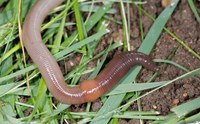Dakota Gardener: Managing earthworm damage in lawns
(Click an image below to view a high-resolution image that can be downloaded)
By Esther E. McGinnis, Horticulturist
NDSU Extension
April showers bring May flowers. Spring rains also brings the first sightings of earthworms on driveways and sidewalks. While this is good fortune for the hungry robins, homeowners often express dismay at the appearance of numerous earthworm castings in lawns.
Earthworm castings are conical-shaped mounds of soil and excrement that are left at the burrow entrance. During heavy rains , earthworms sense raindrop vibrations and leave the soil. Scientists used to believe that they left their burrows because of a lack of oxygen. However, scientists now theorize they take advantage of the wet above-ground environment to look for new habitat and mates.
Numerous earthworm castings in lawns can be unsightly in spring. I wasn’t always appreciative that these castings might cause anguish to conscientious homeowners. I was focused on the numerous soil ecological benefits of earthworms such as thatch decomposition, water infiltration and soil aeration. However, one annoyed homeowner hammered his point home that his lawn was as bumpy as the Badlands and he was afraid that he might trip and break his ankle.
Yes, homeowners can take steps to manage lawn damage. However, the first step is to make sure that earthworms are the issue. Solitary ground-nesting bees can also cause soil mounds in the spring. These native bees are valuable pollinators and not aggressive unlike the pesky yellowjackets that are prevalent in late summer. Ground-nesting bees should not be eradicated.
Fresh earthworm castings are frequently shiny and darker in appearance than the underlying soil. In contrast bee mounds are usually the same color as the soil or even lighter if the underlying soil is sandy. One clear way to differentiate between ground-nesting bees and earthworms is to look for a hole that is about the size of a pencil eraser. Bees leave a prominent hole to allow them to return to their underground nest. Earthworms do not.
Earthworm management strategies are focused on improving turfgrass health, smoothing out the bumps, and overseeding the lawn. No pesticides or chemicals are labeled for use in managing earthworms.
Castings can be masked by a healthy lawn. Mowing at a taller height of 3 to 3.5 inches, fertilizing the lawn, and proper irrigation practices can help. Frequent, shallow watering is detrimental because it keeps the earthworms at the soil surface. In contrast watering deeply but infrequently will force the earthworms deeper as the surface soil dries.
If your lawn is thin, wait until late summer (August 15 to September 15) to core aerate the lawn and overseed with the appropriate turfgrass mix to increase turfgrass density. For this technique to work, the soil cores should be left on the lawn to fill in the low spots. When repeated for multiple years, this technique can help smooth the bumps and increase grass density.
Mechanical processes such powering raking or verticutting can reduce the bumpiness of the soil. Avoid either process during the heat of summer.
NDSU Agriculture Communication – May 8, 2024
Source: Esther McGinnis, 701-231-7406, esther.mcginnis@ndsu.edu
Editor: Kelli Anderson, 701-231-7006, kelli.c.anderson@ndsu.edu




